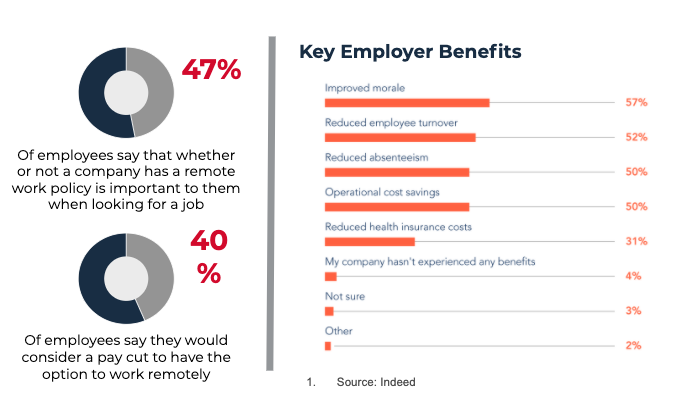The Gist
Remote is becoming the norm in the wake of COVID-19. While remote teams can be efficient with high employee morale, things can fall apart if not properly maintained. Amy Raymond, SVP revenue cycle operations and deployment at AKASA, pulls from her experience as a revenue specialist to offer insights on how revenue leaders can run happy, efficient remote teams.
Many revenue cycle teams at health systems across the country have been navigating a rapid transition to remote work as a result of the COVID-19 pandemic. For most, this was an unplanned transition that had to be navigated under immediate deadlines. This new approach to work is creating challenges and opportunities for revenue cycle leaders.
As a military spouse, the military has directed where our family will live over the past 10 years. I have personally experienced the challenges this creates in building and maintaining my own career trajectory. As a result of this experience, I am passionate about working remotely.
As a revenue cycle leader myself with more than 20 years of experience, I have benefited greatly from being able to tap into a talented workforce that may be dispersed across the country and many of whom require a remote or flexible job due to frequent moves or other lifestyle considerations. Remote positions allow you to keep talent regardless of location and allows employees to keep their job and their career on track through personal transitions. It really can be a win-win for both the organization and employees.
Employer Benefits of Remote Teams
Remote work not only helps employees work a more flexible schedule, but also delivers a number of benefits to employers as well.
- Flexible hours
- Reduced travel time / commute costs
- Less distractions and increased productivity
- Better work / life balance and more time with family
For employers, remote positions can make them an employer of choice and provide access to talent regardless of geographic location. Remote work options can help you retain top talent and help keep morale and job satisfaction high.
Today’s reality is that many revenue cycle leaders are not making the transition to a remote workforce in a normal business environment. When organizations and employees are forced to transition to remote work in response to a crisis, considerations are different. Chances are that adequate time for planning simply wasn’t possible and many of the benefits of working from home can become challenges when families are sheltering in place together.

For individuals who haven’t worked remotely before, it can feel overwhelming to navigate work differently while also navigating their home life in a manner that may be very different than what they are used to as well. The challenge of balancing the needs of their job with the need to help their families navigate this “new normal” is no small feat, especially for employees who need to help their children adapt to remote learning too.
You are not immune to these challenges as a new remote manager either. These challenges affect manager and employee alike!
We tend to be constantly focused on improvement and process. So, we’re picking apart all the things that are wrong, but we do don’t acknowledge when people do meet expectations. That can be small and private or it can be larger and more broadly, like in team meetings when people meet things. The important thing is that success is acknowledged.
~Amy Raymond, VP of Revenue Cycle Operations
Setting Your Remote Team Up for Success
Identify the type of collaboration that needs to be supported — between team members, between team members and management, and with other departments. What tools will be used to share documents, data, information? Does your organization have a dedicated phone line for work from home support or is it the normal Help Desk? Make sure your team keeps this number at hand.
As a leader, you now have to balance your own concerns and the concerns of your management team with the concerns of your team. The good news is that management and employee concerns are often the same — just from different perspectives — and a core set of tools and activities can help you effectively manage both.
Your toolkit for success in managing a remote RCM team should be focused on the following:
- Structure: Create a structure with clear expectations and accountability to provide your team with a greater level of comfort with their boundaries.
- Communication: Over communication is often necessary to ensure the lack of face-to-face interactions does not create misunderstandings.
- Technology: Deploy tools necessary to maintain effective communication with your team, and gain insight into team performance and productivity.
- Data Driven: Use data as much as possible to evaluate staff, determine next steps, and assist with work assignment and completion tracking.
If you’ve already transitioned your team to remote work, it’s not too late to step back and take half a day to review your own priorities for the team and your schedules and processes. Put a plan in place for pulling together all of the necessary pieces in a way that gives your team structure, support, and boundaries. Open communication will be key to keeping your team engaged and morale high during these challenging times. Be open to trying new tools yourself and as a team.
Structure
In terms of structure, start by establishing hours for the team. Where can you allow for flexibility to accommodate the needs of your team during this time, and what are your requirements. Create hours for the team that allow you to know when to expect them to be available and that covers the organization’s needs for your team.
Set up recurring team meetings and individual check ins with staff and consider increasing frequency at least initially while your team is settling into remote work. Allow team members access to subject matter experts, management, and other teams when they need it. Consider having guests from other teams join during your team meetings to provide transparency into processes that are important to your team.
Communication
Effective communication is absolutely critical in a remote setting. I ask my team to think about it in the same way they would if we were in the office together. Would you knock on my office door and come in to ask a question, pick up the phone or send an email? A similar approach is still applicable. Push yourself to use video calls as much as possible as they are a way to show up and be present.. They can also be an important tool for more effective communication while face-to-face interaction is limited.
Clear direction on which communication channels can be used and under what circumstances is critical to staying in compliance with protected patient health information (PHI) and HIPAA requirements. What are the approved modes of communication — which methods are PHI compliant? Instant messaging and chat are helpful for ad hoc, ongoing conversations. Email may be preferred for more formal communication.
Technology
Many RCM analysts may not be familiar with project management tools, but project sharing tools are great for teams working toward common goals. Video meetings are especially helpful to help teams feel connected to you and to each other while working remotely. It can be best to use video for any team meetings, scheduled check-ins, and sensitive discussions. Explicitly train your team on when to use email, chat, phone and video communications in order to create structure for the team and to ensure your team operates in a manner that keeps (PHI) secure.
Data-Driven Approach
As much as possible, take a data-driven approach to discussions regarding staff deliverables. Overanalyze the data you have to ensure you understand the current state of your team. Lean into the technologies you have, do the tools and technologies you already use offer reports or features that can provide a line of sight into team productivity? Reach out to your current vendors to see if they may be able to offer something as a value-added service during this time.
Expect productivity to decline, at least in the beginning, while team members adapt to a new work setting. Identify and clearly communicate acceptable thresholds and what will be done to mitigate performance and productivity concerns. Encourage managers to be direct about productivity, quality, and any other concerns — be ready to talk about it and be ready to offer guidance.
In addition to bringing together the structure, communication, technology and data, continue the best of what you are already doing, but modify it to work remotely
- Have fun! Team games on chat/ IM, virtual games, selfie challenges
- Share reports
- Give “shout outs”
- Encourage collaboration
Considerations for Managing Remote Revenue Cycle Teams
Finally, there are a few things to consider that are specific to managing revenue cycle teams remotely. First, how you manage your A/R may need to shift. You may be experiencing volume changes — have you seen a decrease? If so, how are you redeploying staff? Now is the time to redirect staff to accounts and areas that you haven’t previously had capacity to address. Is there an opportunity to improve revenue capture by actively working aged accounts, denial appeals, underpayments and uncollectibles?
Finally, your organization may have put policy changes in place as a result of COVID-19 to limit contact with patients, which may have impacted accuracy of patient information captured during registration, this in turn can impact workflows related to eligibility and cash collection.
Understand how volume changes and policy changes in Patient Access could impact your workload. In the mid cycle, consider holding frequent routine meetings with coding and medical records to stay aware of productivity issues in their areas that may result in billing delays. In the business office, might you expect an increased need for billing edit reports? Days in AR will be as critical as ever. How might you expect your age and success of collection efforts to shift? Proactively communicate those expected changes with management and your team.
Keep a close eye on your available reports and consider breaking them down further to understand productivity, progress being made, and how to redeploy resources to make the biggest impact:
- Collection reports by payer
- Problem payer reports
- High balance
- Queue counts and action code/ productivity reports
- Collections by payer

Keep a close eye on collections reports by payer so you can understand if there are decreases in payment. Problem payer reports will also be particularly important. Consider re-deploying staff to work existing issues that are high touch or need more time to resolve but can return high value to the organization. As your team acclimates to remote life, look into lean management tactics to keep things running as smoothly as possible, too. Finally, be patient, with yourself and your staff. You redeployed at lightning speed to meet the immediate demands created by COVID-19. Getting used to the new normal will take time, but you and your team will get better at it every day.
To make life easier for you and your remote team, consider automating as much of the revenue cycle as you can. At AKASA, we provide a generative AI-powered solution specifically built for the revenue cycle. Our unique expert-in-the-loop approach combines modern generative AI with human judgment and subject matter expertise in one resilient platform.
To learn more about AKASA and our platform , request a free demo and see how we can streamline the revenue cycle for your organization today.

Amy Raymond serves as the senior vice president of revenue cycle operations and deployments at AKASA, where she maintains operational responsibility for the production and performance of the firm’s AI-driven automation platform. Across her 25-year career in revenue cycle, Raymond has held several leadership, consulting, and implementation roles. Her industry experience includes tenures at national and regional health systems, as well as numerous care settings and specialties. Most recently, Raymond served as a senior leader in the revenue cycle technology vertical at Advisory Board. Her extensive professional expertise includes: end-to-end revenue cycle operations, process redesign/optimization, patient financial experience improvement, technology deployment/adoption, change management, and employee engagement. As a military spouse, Raymond is a passionate advocate for mil-spouse hiring and community support.










